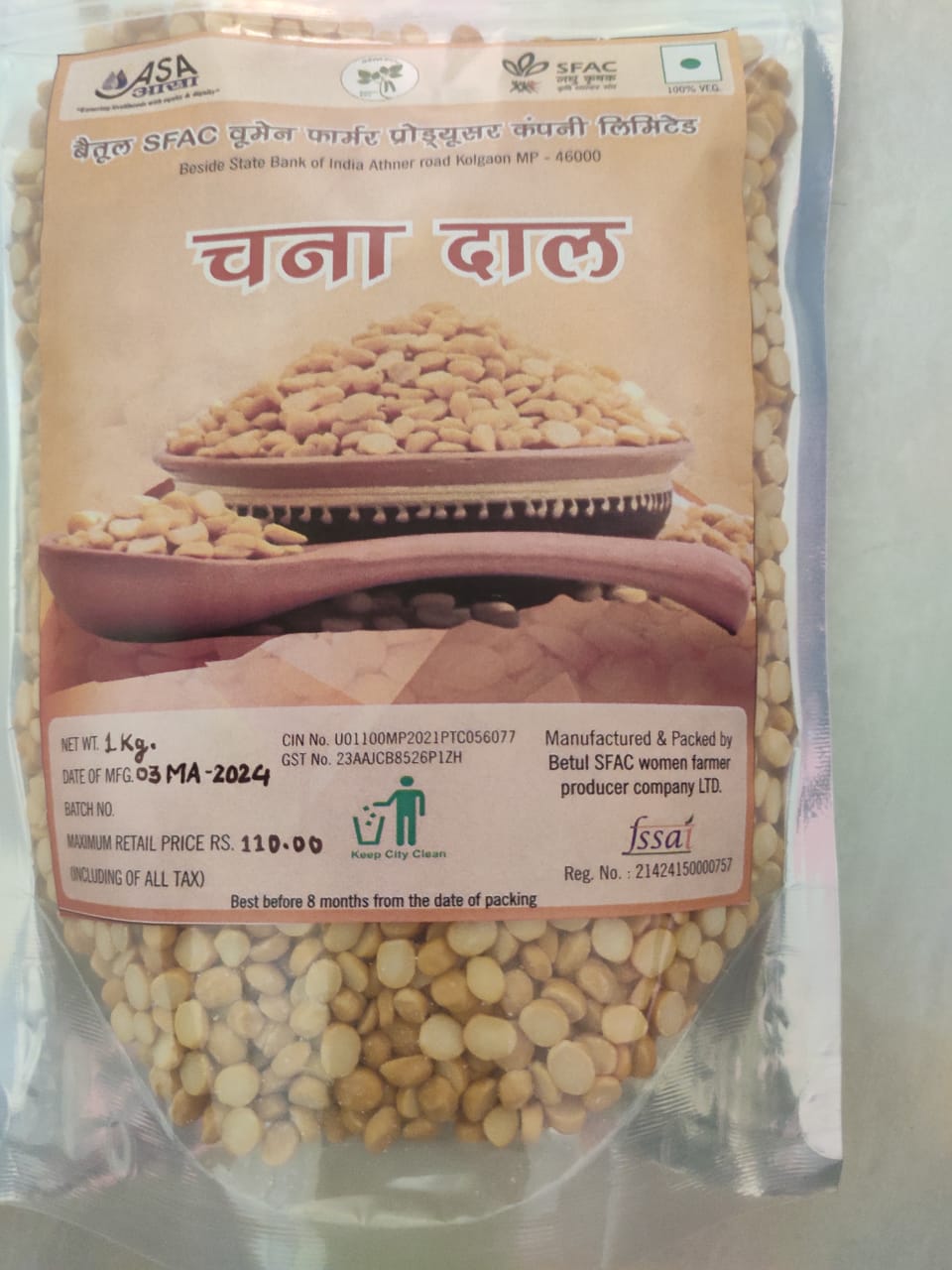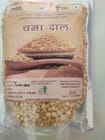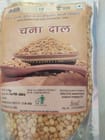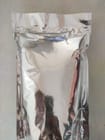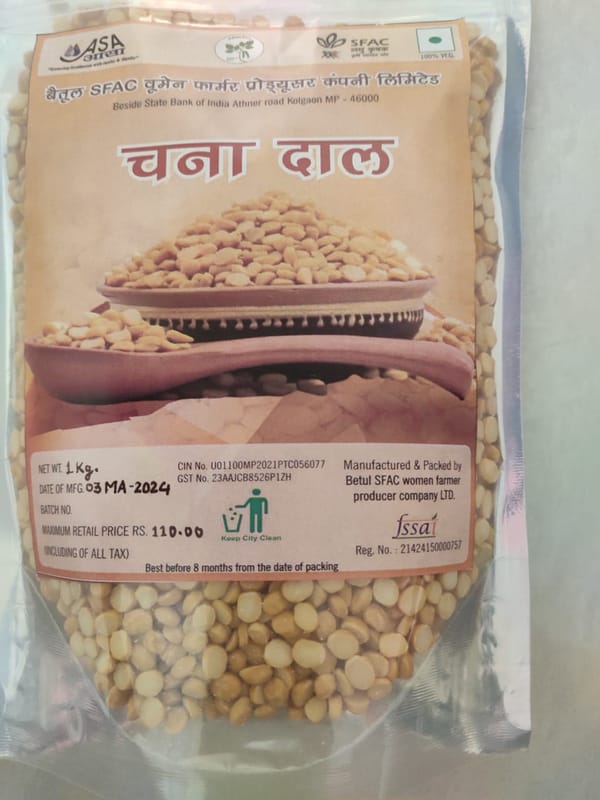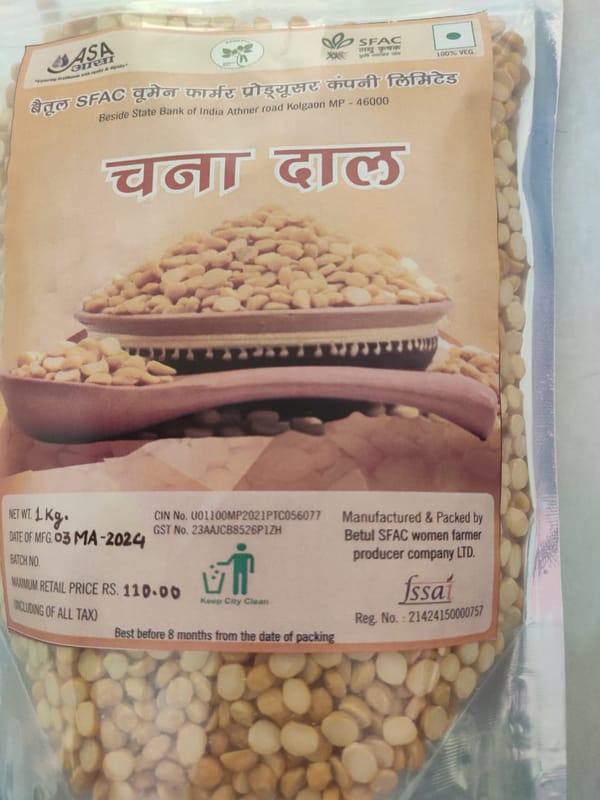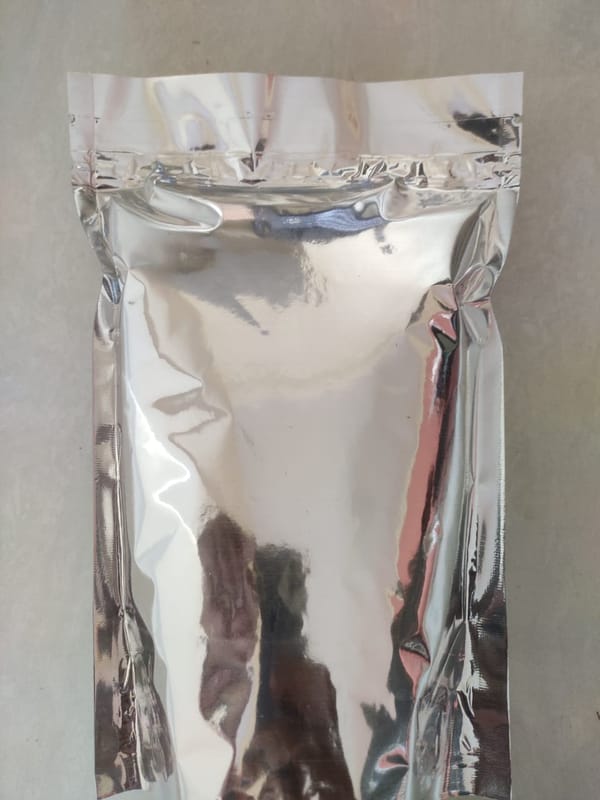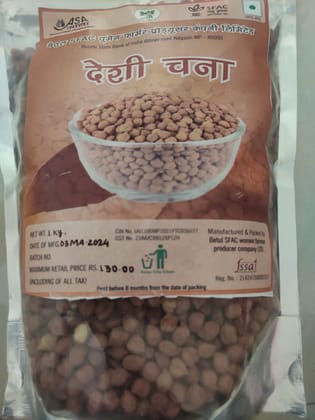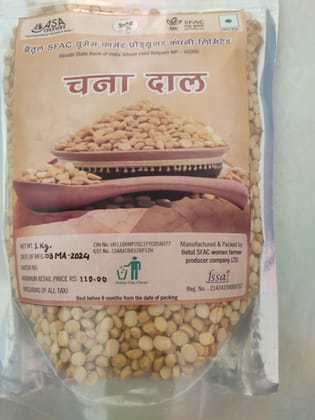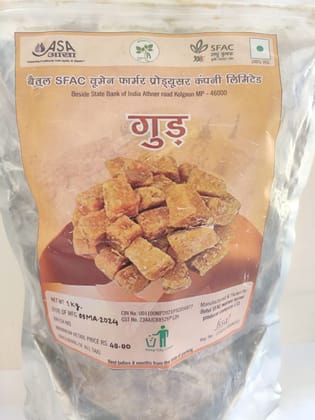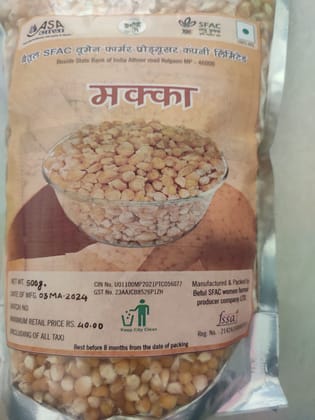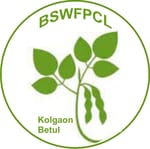Chana Dal
Veg
Key Attributes
| Country of origin | India |
|---|---|
| Net Quantity | 1000 gram |
| Manufacturer or packer name | Betul SFAC women farmer producer company LTD |
Chana dal, also known as split chickpeas, is a type of pulse made by splitting a tiny, beige-colored chickpea (garbanzo bean) and removing its outer layer. It's a staple ingredient in Indian cuisine and is widely used in various dishes such as dal (lentil soup), curries, stews, and even sweets.
Here are some key features and uses of chana dal:
-
Nutritional Profile: Chana dal is rich in protein, fiber, and essential nutrients like iron, calcium, and magnesium. It's a good source of plant-based protein, making it an excellent choice for vegetarians and vegans.
-
Texture and Flavor: Chana dal has a slightly sweet and nutty flavor with a grainy texture when cooked. It retains its shape even after cooking, making it suitable for both soupy and thick preparations.
-
Cooking Method: Before cooking, chana dal is often soaked in water for a few hours to soften it and reduce cooking time. It can be boiled, pressure-cooked, or slow-cooked until tender.
-
Versatility: Chana dal can be used in a variety of dishes. It's commonly used to make dal, where it's cooked with spices and aromatics like onions, garlic, ginger, and tomatoes. It's also used in snacks like dal pakoras (fritters) and sweets like chana dal halwa. In some regions, it's ground into flour and used to make savory pancakes or deep-fried snacks.
-
Health Benefits: Due to its high fiber content, chana dal aids digestion and helps regulate blood sugar levels. It's also beneficial for heart health and weight management.
-
Cultural Significance: Chana dal holds cultural significance in Indian cuisine and is often used in festive and celebratory dishes. It's a symbol of prosperity and is commonly included in religious rituals and offerings.
Overall, chana dal is a versatile and nutritious ingredient that adds depth of flavor and texture to a wide range of dishes, making it a popular choice in Indian cooking.
| Country of origin | India |
|---|---|
| Common name | Chana Dal |
| Net Quantity | 1000 gram |
| Additive info | Chana dal, being a natural food product, typically doesn't contain additives if purchased in its pure form. However, in processed or packaged chana dal products, especially those sold commercially, additives might be included for various purposes such as enhancing flavor, extending shelf life, or improving texture. Here are some additives commonly found in processed or packaged chana dal products, along with their purposes: Preservatives: Additives like potassium sorbate or sodium benzoate are often used to inhibit the growth of bacteria, mold, and yeast, thus extending the shelf life of the product. Antioxidants: Substances such as butylated hydroxytoluene (BHT) or butylated hydroxyanisole (BHA) may be added to prevent oxidation and rancidity, thereby maintaining the freshness of the product. Colorants: Artificial or natural colorants may be added to enhance the appearance of the chana dal or to give it a more uniform color. Flavor Enhancers: Additives like monosodium glutamate (MSG) or yeast extract might be included to enhance the natural flavor of the chana dal or to create a specific taste profile. Texturizers: Certain additives such as modified starches or gums may be added to improve the texture or mouthfeel of the chana dal product. Anti-caking Agents: To prevent clumping or caking, anti-caking agents like silicon dioxide or calcium silicate may be added to chana dal products, especially if they are ground or powdered. It's important to note that while some additives are generally recognized as safe for consumption by regulatory authorities, others may raise concerns, especially if consumed in large quantities or by individuals with specific dietary restrictions or sensitivities. Reading ingredient labels and understanding the purpose of additives can help consumers make informed choices about the products they purchase. If you prefer to avoid additives, opting for organic or minimally processed chana dal products may be a suitable option. |
| Weight | 500 g |
| Food type | veg |
| Manufacturer or packer name | Betul SFAC women farmer producer company LTD |
| Manufacturer or packer address | Beside State bank of India Athner road kolgaon Dist- Betul MP |
| Manufacturing Date | 03/2024 |
| Nutritional information | Chana dal is a nutritious pulse that offers several health benefits. Here's a breakdown of its nutritional profile per 100 grams of cooked chana dal: Calories: Approximately 165 kcal Protein: About 8-9 grams Carbohydrates: Around 25-27 grams Fiber: Roughly 8-9 grams Fat: 2-3 grams Iron: Provides about 1-2 mg Calcium: Contains approximately 35-40 mg Magnesium: Provides around 45-50 mg Potassium: Contains roughly 300-350 mg Chana dal is particularly rich in protein and fiber, making it a filling and satisfying option. Its high fiber content aids digestion, helps in maintaining a healthy gut, and regulates blood sugar levels. Additionally, the protein content makes it an excellent choice for vegetarians and vegans looking to meet their protein needs. The dal also contains essential minerals like iron, calcium, magnesium, and potassium, which are important for various bodily functions, including bone health, muscle function, and energy metabolism. Overall, chana dal is a nutritious addition to your diet, offering a good balance of macronutrients and micronutrients. Incorporating it into your meals can contribute to a healthy and well-rounded diet. |
| Instructions | Soaking: Rinse 1 cup of chana dal under cold water until the water runs clear. Transfer the rinsed dal to a bowl and cover it with about 3 cups of water. Allow it to soak for at least 4 hours, or preferably overnight. Soaking helps soften the dal and reduces cooking time. Drain and Rinse: After soaking, drain the water from the dal and rinse it once again under cold water to remove any remaining debris. Cooking on Stove: In a large pot, add the soaked and rinsed chana dal along with 3 cups of fresh water. Bring the water to a boil over medium-high heat. Once boiling, reduce the heat to low and cover the pot with a lid. Let the dal simmer for about 30-40 minutes or until it becomes soft and tender. Stir occasionally to prevent sticking. If necessary, add more water during cooking to achieve your desired consistency. Seasoning: Once the dal is cooked, add salt to taste and any optional spices for flavoring. Common spices include turmeric, cumin seeds, mustard seeds, garlic, ginger, onions, tomatoes, green chilies, and cilantro. Adjust the seasoning according to your taste preferences. Tempering (Optional): In a small pan, heat some oil or ghee over medium heat. Add spices like cumin seeds, mustard seeds, and dried red chilies to the hot oil. Let the spices sizzle for a few seconds until fragrant, being careful not to burn them. Pour the tempered oil and spices over the cooked dal and stir to combine. Serve: Once seasoned and optionally tempered, turn off the heat and let the dal sit for a couple of minutes. Serve the chana dal hot with rice, roti, or naan. Garnish with fresh cilantro leaves for extra flavor and freshness. Enjoy your delicious homemade chana dal! |
| contact details consumer care | BETUL SFAC WOMEN FARMER PRODUCER COMPANYLIMITED, [email protected] |
